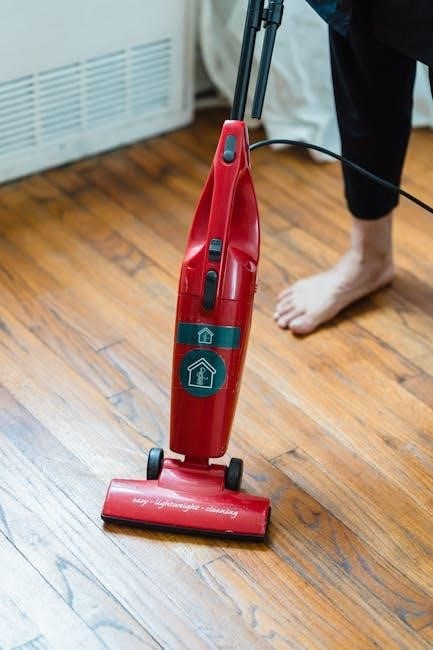Safety Guidelines
Always operate the compressor in a well-ventilated area, free from flammable materials. Avoid exceeding a 50% duty cycle to prevent overheating. Never modify the tool or use unauthorized accessories, as this could lead to explosion risks or fire hazards. Ensure proper grounding and follow all safety instructions to minimize risks during operation and maintenance.
1.1 General Safety Precautions
Always operate the Porter-Cable air compressor in a well-ventilated area, free from combustible materials, gasoline, or solvent vapors. Ensure the compressor is properly grounded to prevent electrical shocks. Never exceed the recommended 50% duty cycle, as excessive operation may lead to overheating. Avoid pointing nozzles or sprayers toward people or animals to prevent injury. Turn off the compressor and bleed pressure from the air hose and tank before performing any maintenance or attaching tools. Regularly inspect the air tank for rust or damage, and replace it if necessary. Follow all safety guidelines in the user manual to minimize risks of explosion, fire, or equipment damage.
1.2 Handling and Operation Precautions
Always handle the Porter-Cable air compressor with care to avoid accidental damage. Ensure the unit is placed on a stable, level surface before operation. Never operate the compressor near open flames, sparks, or in areas where flammable vapors are present. Keep loose clothing and long hair tied back to avoid entanglement with moving parts. Wear safety glasses and ensure bystanders are at a safe distance. Avoid overloading the compressor beyond its rated capacity, as this can lead to reduced performance and increased wear. Regularly check the duty cycle to prevent overheating. Always follow the manufacturer’s instructions for attaching tools and accessories, and ensure all connections are secure before starting the compressor. Proper handling ensures safe and efficient operation.
1.3 Potential Hazards and Risks
Operating the Porter-Cable air compressor poses potential hazards if proper safety measures are not followed. The primary risks include explosion or fire due to improper ventilation or flammable materials nearby. High-pressure air can cause severe injury if misdirected or used improperly. Additionally, moving parts may entangle loose clothing or hair, leading to accidents. Overheating from exceeding the 50% duty cycle can damage the compressor and pose fire risks. Regular maintenance is crucial to prevent wear and tear, which could lead to unexpected malfunctions. Always ensure the air tank is properly vented to avoid moisture buildup, as this can rust the tank and weaken its structure, potentially causing a catastrophic failure. Adhering to the user manual’s guidelines minimizes these risks and ensures safe operation.
1.4 Compliance with Regulations
Ensure your Porter-Cable air compressor operation aligns with local and national safety regulations. The compressor must comply with electrical and environmental standards, such as proper grounding to prevent shocks. Regular inspections are required to maintain compliance and safety. Always follow regional guidelines for air compressor usage in residential or commercial settings. Familiarize yourself with noise level restrictions to avoid violations. Proper disposal of compressor components and fluids is mandatory to meet environmental regulations. Additionally, always ensure the air tank is inspected and recertified as per local laws to prevent potential hazards. Compliance ensures safe and legal operation, protecting both users and the environment. Stay informed about updates to regulations affecting your compressor’s use and maintenance.

Product Features and Specifications
The Porter-Cable air compressor features a 30-gallon tank, 135 PSI maximum pressure, and efficient electric operation. Designed for versatility, it supports both household and small commercial applications effectively.
2.1 Key Components of the Compressor
The Porter-Cable air compressor consists of a robust 30-gallon vertical air tank, a high-efficiency electric motor, and a reliable compressor pump. The pressure switch regulates tank pressure, ensuring safe operation. Additional components include a pressure gauge, air outlet, and safety valve. The compressor pump compresses air into the tank, while the motor drives the pump. The air tank stores compressed air for tool operation. The pressure gauge monitors tank pressure, and the safety valve releases excess pressure to prevent hazards. These components work together to provide consistent and reliable air compression for various applications. Regular maintenance of these parts ensures optimal performance and longevity of the compressor.
2.2 Technical Specifications
The Porter-Cable air compressor features a 30-gallon vertical tank, delivering up to 135 PSI maximum pressure. It operates on a 120V/60Hz electrical system with a 15-amp motor, ensuring efficient performance. The compressor has a 50% duty cycle, meaning it can run for 30 minutes out of every hour to prevent overheating. The tank is designed for heavy-duty use, with a robust steel construction for durability. The unit includes a 1/4″ NPT quick-connect coupler for easy tool attachment. Airflow is rated at 4.0 CFM at 90 PSI and 4.3 CFM at 40 PSI, providing sufficient power for most pneumatic tools. These specifications ensure reliable operation for both household and small-scale industrial applications, making it a versatile choice for various tasks. The compressor is also designed with a compact footprint for easy storage and portability.
2.3 Included Accessories
The Porter-Cable air compressor comes with essential accessories to ensure optimal performance and convenience. These include a 1/4″ NPT quick-connect coupler for easy tool attachment, a pressure gauge for monitoring tank pressure, and a drain valve for efficient tank drainage. Additionally, the unit is equipped with a 6-foot power cord, enabling flexible placement during operation. The package also includes a comprehensive owner’s manual, detailing safety guidelines, technical specifications, and maintenance procedures. These accessories are designed to enhance functionality and user experience, providing everything needed to get started with your air compressor right out of the box. The included components are carefully selected to support both household and professional applications, ensuring versatility and reliability.
2.4 Optional Equipment and Accessories
Porter-Cable offers a range of optional equipment and accessories to enhance the functionality of your air compressor. These include high-capacity air hoses for extended reach, digital pressure gauges for precise monitoring, and upgraded condensation management systems to reduce moisture buildup. Additional accessories like air tool kits, such as impact wrenches and sanders, are also available to expand the compressor’s versatility. Optional maintenance kits, including piston rings and gasket sets, can be purchased for DIY repairs. For improved portability, a heavy-duty wheel kit can be added. These optional items allow users to customize their setup based on specific needs, ensuring optimal performance for both household and professional applications. Optional accessories are designed to complement the compressor’s capabilities, offering enhanced convenience and efficiency.

Installation and Setup
Ensure the site is level and well-ventilated. Connect the compressor to a suitable electrical circuit as specified. Install the air tank securely and follow the setup checklist for proper initialization.
3.1 Site Preparation
Before installation, ensure the site is level, firm, and well-ventilated. Choose a location away from flammable materials and ensure proper drainage to prevent water accumulation. The area should be clean and free from debris to avoid contamination. Check for adequate electrical connections and grounding as specified in the manual. Ensure the surface is stable to prevent vibration during operation. Avoid placing the compressor near open flames or sparks. Proper site preparation ensures safe and efficient operation of the Porter-Cable air compressor. Always follow the manufacturer’s guidelines for optimal setup conditions.
3.2 Electrical Installation Requirements
Ensure the electrical circuit meets the compressor’s voltage and amperage requirements. Use a dedicated 20-amp circuit to prevent overloading. The compressor must be properly grounded to avoid electrical hazards. Install a circuit breaker suitable for the compressor’s power consumption. Avoid using extension cords, as they can cause voltage drops and safety risks. Ensure all electrical connections are secure and meet local electrical codes. Consult a licensed electrician if unsure. Keep the area around electrical components clean and dry to prevent short circuits. Proper electrical installation ensures safe and reliable operation of the Porter-Cable air compressor, reducing the risk of electrical fires or malfunctions.
3.3 Air Tank Installation
Install the air tank on a level, stable surface to prevent tipping. Secure the tank using mounting brackets or straps to ensure stability. Connect the tank to the compressor using high-quality, leak-proof fittings and hoses rated for the compressor’s maximum pressure. Ensure all connections are tightened properly to avoid air leaks. Before use, check the tank’s pressure rating and ensure it matches the compressor’s output. Inspect the tank for any damage or rust, and replace if necessary. Always follow the manufacturer’s guidelines for tank installation and maintenance. Proper installation ensures safe and efficient operation of the Porter-Cable air compressor, minimizing risks of leaks or damage.
3.4 Initial Setup Checklist
Before first use, inspect the compressor and air tank for any damage or leaks. Ensure the unit is placed on a level, stable surface in a well-ventilated area. Connect the power supply according to the voltage and frequency specified in the manual. Attach the air hose securely to the compressor and tank; Bleed pressure from the system by opening the drain valve before powering on. Test the compressor at a low setting to ensure proper operation. Check for any air leaks in connections and tighten as needed. Familiarize yourself with the pressure gauge and safety valve. Review the user manual for specific startup procedures and safety precautions. This checklist ensures a safe and efficient initial setup of your Porter-Cable air compressor.

Operating Instructions
Start the compressor as per the manual, ensuring a 50% duty cycle. Allow proper cooling breaks to prevent overheating. Operate in a well-ventilated area, free from flammable materials. Always monitor the pressure gauge and release pressure before maintenance. Follow all safety guidelines to avoid potential hazards.
4.1 Starting the Compressor
Before starting, ensure the compressor is in a well-ventilated area, free from flammable materials. Check the pressure gauge to ensure it matches the recommended settings. Plug in the unit and turn it on, allowing it to build pressure gradually. Once the tank reaches the desired pressure, the compressor will automatically shut off. Always monitor the pressure gauge during operation to avoid over-pressurization. Ensure the duty cycle does not exceed 50% to prevent overheating. If the compressor does not start, check the power supply and ensure all connections are secure. Refer to the manual for troubleshooting common startup issues. Always follow safety guidelines to ensure safe and efficient operation.
4.2 Using Air-Powered Tools
When using air-powered tools with your Porter-Cable air compressor, ensure the tool is properly connected to the air hose and that all connections are secure. Always check for leaks before use. Set the compressor to the recommended pressure for your tool, as specified in the user manual. Avoid exceeding the maximum pressure rating of the tool or hose. Keep the tools pointed away from people, animals, and flammable materials. Follow proper safety guidelines, such as wearing eye protection and ensuring the work area is clear of hazards; Never leave the compressor running unattended while tools are in use. After use, turn off the compressor and bleed the air from the tank and hose. Always refer to the tool’s specific instructions for optimal performance and safety.
4.3 Monitoring Compressor Performance
Regularly monitor the compressor’s performance to ensure optimal operation. Check the pressure gauge frequently to maintain the recommended settings and avoid overloading the system. Listen for unusual noises or vibrations, which may indicate wear or misalignment. Inspect the air filter and ensure it is clean to maintain efficient airflow. Monitor the duty cycle to prevent overheating, ensuring the compressor does not exceed 50% operation time in any hour. Check for leaks in hoses and connections, as they can reduce efficiency and safety. Record maintenance activities and performance metrics to track the compressor’s condition over time. Always refer to the user manual for specific guidelines on monitoring and addressing performance issues promptly.
4.4 Shutting Down Procedures
To safely shut down the Porter-Cable air compressor, first turn off the power switch and unplug the unit from the electrical outlet. Allow the compressor to cool down completely before proceeding. Bleed all remaining pressure from the air tank and hoses by opening the drain valve. Disconnect any attached tools or accessories to ensure no residual air is stored in the system. Always perform a visual inspection to confirm the system is depressurized and safe for maintenance or storage. Never leave the compressor unattended while it is operational or during shutdown; Follow these steps meticulously to prevent accidents and ensure the compressor remains in optimal condition for future use.

Maintenance and Care
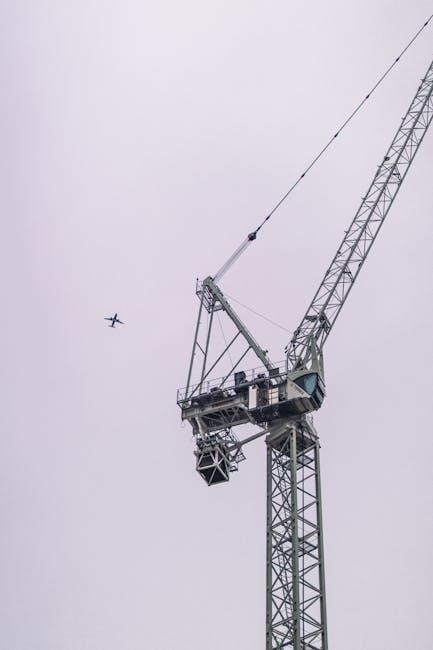
Regular maintenance ensures optimal performance and longevity. Check for wear, drain moisture daily, and replace filters as needed. Lubricate moving parts and inspect belts. Follow manual guidelines for motor care and tank inspection to prevent damage. Address any issues promptly to maintain efficiency and safety.
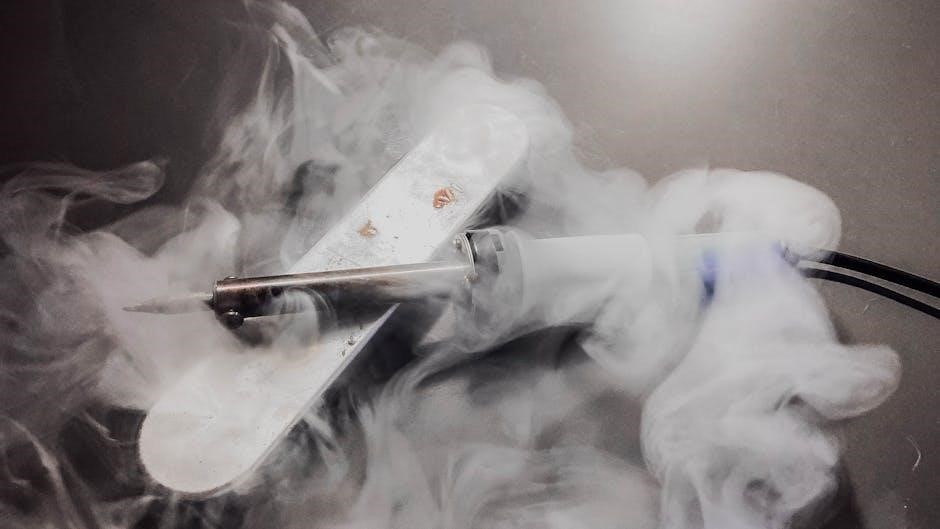
5.1 Daily Maintenance Checks
Perform daily checks to ensure your Porter-Cable air compressor operates safely and efficiently. Begin by inspecting the power cord and electrical connections for damage or wear. Check the air filter for cleanliness and replace it if clogged. Drain moisture from the air tank to prevent rust and corrosion. Inspect the belt and pulleys for proper alignment and tension. Listen for unusual noises that may indicate worn or loose parts. Ensure all safety valves are functioning correctly. Verify that the pressure gauge is accurate and within recommended limits. Finally, review the duty cycle to avoid overheating. Address any issues immediately to maintain performance and longevity.
5.2 Weekly Maintenance Routine
Weekly maintenance is crucial for optimal performance and longevity of your Porter-Cable air compressor. Start by cleaning the compressor unit, removing dust and debris that may affect cooling. Check and replace the air filter if necessary to ensure proper airflow. Inspect the oil level in the pump and top it off as needed to prevent overheating. Examine the hoses and connections for leaks or damage, replacing them if required. Run the compressor without a load to test its operation. Lubricate moving parts according to the manufacturer’s recommendations to reduce friction and wear. Finally, review the previous week’s usage to identify potential issues early. Regular upkeep helps maintain efficiency and reliability, ensuring your compressor continues to perform at its best.
5.3 Replacing Parts and Accessories
Replacing parts and accessories on your Porter-Cable air compressor is essential for maintaining its performance and safety. Always turn off the compressor and bleed all pressure from the tank and hoses before starting any replacement. Use only genuine Porter-Cable parts to ensure compatibility and reliability. Common replacements include air filters, oil, and seals. Refer to the user manual or manufacturer’s website for specific instructions and diagrams. For complex parts like the cylinder kit, consider watching instructional videos or consulting a professional. Proper installation of new components is critical to prevent leaks and ensure optimal operation. Keep track of replacement dates to maintain warranty validity and extend the lifespan of your compressor.
5.4 Troubleshooting Common Issues
Troubleshooting your Porter-Cable air compressor involves identifying common issues and addressing them promptly. Low pressure or slow air flow may indicate air leaks in hoses or connections. Check and tighten all fittings. If the compressor fails to start, ensure the circuit is properly grounded and the outlet has power. Overheating can occur from excessive use beyond the 50% duty cycle—allow the unit to cool down. For loud noises, inspect the belt or motor for wear. If the tank doesn’t hold air, check for cracks or rust and replace if necessary. Refer to the user manual for diagnostic guides or consult a professional for complex repairs. Regular maintenance can prevent many of these issues and ensure optimal performance.
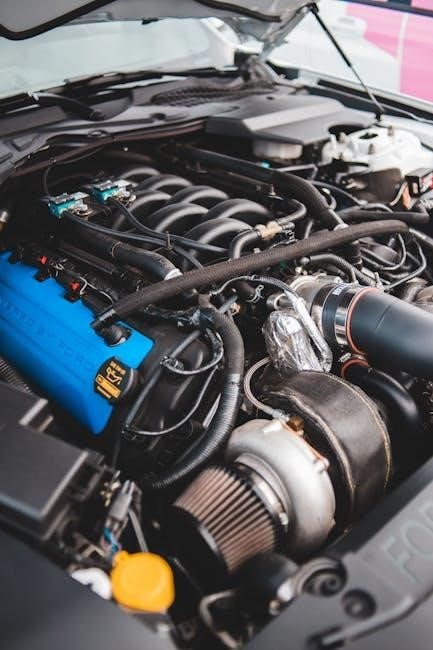
Storage and Transportation
Store the compressor in a dry, cool place, away from direct sunlight. Drain the tank after use to prevent rust. Transport securely, ensuring the unit is empty and well-secured to avoid damage.
6.1 Proper Storage Conditions
Store the Porter-Cable air compressor in a dry, cool, and well-ventilated area to prevent rust and damage. Ensure the storage space is free from direct sunlight and flammable materials. After use, drain the air tank completely to avoid moisture buildup, which can lead to rust. Keep the compressor away from high-humidity environments and ensure it is placed on a stable, level surface. Avoid storing the unit in areas with extreme temperatures or exposure to chemicals. Proper storage conditions will help maintain the compressor’s performance and longevity, ensuring it remains in good working condition for future use.
6.2 Safe Transportation Guidelines
When transporting the Porter-Cable air compressor, ensure it is securely fastened to prevent movement and damage. Drain the air tank before moving to avoid any residual pressure. Use a suitable vehicle with adequate space to accommodate the compressor’s size and weight. Always follow local transportation regulations and avoid sudden accelerations or sharp turns. Protective coverings or padding can help safeguard the unit during transit. Never leave the compressor unattended in an unsecured vehicle. Proper transportation practices minimize the risk of damage and ensure the compressor arrives in optimal condition for its next use.
6.3 Preparing for Long-Term Storage
To prepare the Porter-Cable air compressor for long-term storage, thoroughly drain the air tank and disconnect it from the compressor. Clean the unit to remove dirt and moisture, ensuring all components are dry. Apply a rust-inhibiting coating to metal parts to prevent corrosion. Store the compressor in a cool, dry, well-ventilated area away from direct sunlight and flammable materials. Cover the unit with a breathable material to protect it from dust. Regularly inspect stored components to ensure they remain in good condition. Proper storage extends the lifespan of the compressor and ensures it remains ready for future use without requiring extensive maintenance.
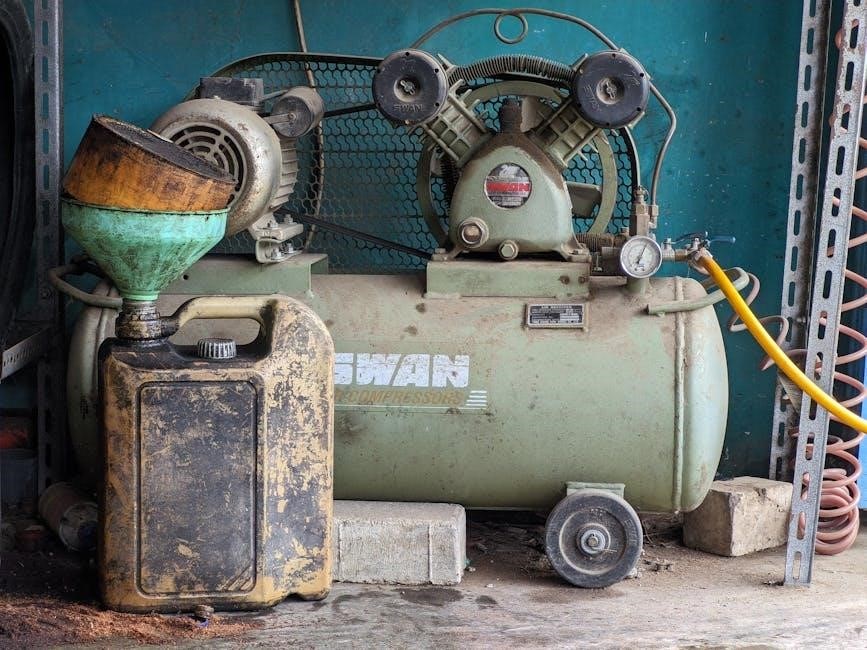
Warranty and Support
Porter-Cable offers a 2-year warranty for pneumatic tools and 1-year for pressure washers. Register your product and access support through SERVICENET for manuals and assistance.
7.1 Warranty Terms and Conditions
Porter-Cable air compressors are backed by a limited warranty, ensuring protection against defects in materials and workmanship. The warranty period varies by product: pneumatic tools are covered for 2 years, while pressure washers receive 1 year of coverage. To make a claim, contact customer support and provide proof of purchase. The warranty does not cover damage resulting from misuse, unauthorized modifications, or improper maintenance. For detailed terms, refer to the official warranty document available on the Porter-Cable website or through SERVICENET. Proper registration and adherence to guidelines ensure full coverage, providing peace of mind for your investment.
7.2 Registering Your Product
Registering your Porter-Cable air compressor is essential for warranty validation and support; Visit the SERVICENET portal, enter your product’s model number, and follow the registration process. Ensure all details, including purchase date and serial number, are accurate. Registration provides access to exclusive updates, troubleshooting resources, and extended customer support. Maintain a record of your registration for future reference. This step ensures seamless service and verifies your product’s authenticity, enabling Porter-Cable to assist you effectively. Proper registration also aids in tracking and resolving any potential issues promptly.
7.3 Contacting Customer Support
To contact Porter-Cable customer support, visit their official website and navigate to the support section. Use the SERVICENET portal to access resources, manuals, and troubleshooting guides. For direct assistance, call the customer service hotline or submit a query via the online contact form. Ensure you have your product’s model number and purchase details ready for efficient support. The website also provides FAQs, service center locations, and warranty information. Representatives are available to address inquiries, provide repair options, and guide you through technical issues. This ensures timely resolution and optimal use of your Porter-Cable air compressor. Utilize these resources to maintain your product’s performance and extend its lifespan.
7.4 Service Centers and Repair Options
For professional repair and maintenance, locate an authorized Porter-Cable service center through the SERVICENET portal or the official website. These centers are equipped to handle compressor repairs using genuine parts, ensuring compliance with warranty terms. Contact customer support to find the nearest service center or to inquire about repair options. Always use authorized repair services to maintain your compressor’s performance and warranty validity. Service centers offer expertise in diagnosing and resolving technical issues, ensuring your air compressor operates safely and efficiently. Regular maintenance and repairs by certified technicians can extend the product’s lifespan and prevent potential hazards. Utilize these resources to keep your Porter-Cable air compressor in optimal working condition;
Adhering to the guidelines ensures optimal performance and safety. Regular maintenance and servicing are crucial for longevity. Proper care ensures efficient, safe, and reliable operation.

8.1 Final Tips for Optimal Use
For optimal performance, always follow the manufacturer’s guidelines and maintain regular checks. Ensure the compressor is used in well-ventilated areas, away from flammable materials. Regularly inspect hoses and connections for leaks or damage. Avoid overloading the compressor beyond its rated capacity. Keep the duty cycle at 50% or below to prevent overheating. Store the unit in a dry, cool place when not in use. Refer to the manual for troubleshooting common issues promptly. For complex repairs, consult authorized service centers. Plan tasks according to usage needs to maximize efficiency. Proper care and adherence to safety protocols ensure long-term reliability and safety.
8.2 Importance of Regular Maintenance
Regular maintenance is crucial for ensuring the longevity and efficiency of your Porter-Cable air compressor. Daily checks, such as inspecting hoses, connections, and gauges, help prevent leaks and malfunctions. Weekly routines, like cleaning filters and checking oil levels, maintain optimal performance. Addressing minor issues promptly avoids costly repairs. Proper maintenance also reduces the risk of overheating and extends the compressor’s lifespan. Always refer to the user manual for specific maintenance schedules and procedures. A well-maintained compressor ensures reliable operation, reduces downtime, and enhances overall productivity. Neglecting maintenance can lead to premature wear, safety hazards, and reduced efficiency. Consistent care is essential for maximizing your investment and ensuring safe, efficient operation.
8.3 Ensuring Safety and Efficiency
Ensuring safety and efficiency is paramount when operating a Porter-Cable air compressor. Always operate in a well-ventilated area, away from flammable materials, and never exceed the recommended duty cycle to prevent overheating. Regular maintenance, such as checking hoses and filters, ensures optimal performance and reduces the risk of malfunctions. Properly grounding the compressor and following all safety guidelines minimizes hazards. Efficient operation involves using the correct pressure settings for your tools and avoiding unnecessary strain on the motor. By adhering to these practices, you can ensure safe, reliable, and efficient operation of your Porter-Cable air compressor, extending its lifespan and preventing potential risks. Consistent adherence to safety and efficiency protocols guarantees a trouble-free experience.
